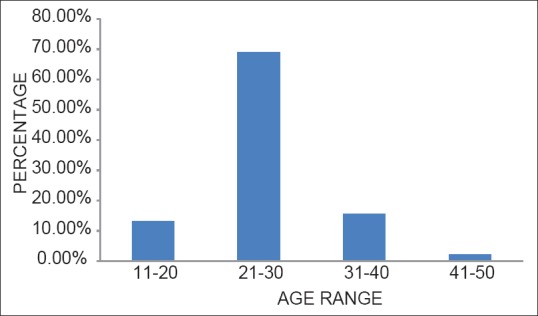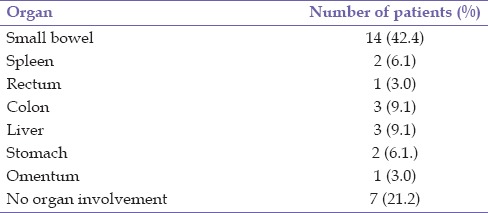Abstract
Background:
Abdominal injury is relatively common in both civilian and military casualties and remains a major source of morbidity and mortality. The mechanism of injury may be blunt or penetrating. Some would require operative intervention, whereas others may be managed conservatively.
Objective:
The aim was to determine the pattern and outcome of management of abdominal injuries in the University of Port Harcourt Teaching Hospital (UPTH).
Patients and Methods:
This was a prospective study of all patients with abdominal injuries seen and managed in UPTH over a 4-year period (from January 1, 2009 to December 31, 2012). Relevant data were recorded and analyzed using Statistical Package for Social Sciences version 16.
Results:
Forty-five patients were seen during the study period. There were 40 males (88.9%) and five females (11.1%) making a male to female ratio of 8:1. Their ages ranged from 15 to 45 years with a mean of 27.8 ± 1.6 years and 21 to 30 years was the most commonly affected age group. The mechanism of injury was penetrating in 33 patients (73.3%) and blunt in 12 patients (26.7%). Thirty-four patients (75.6%) had an exploratory laparotomy after resuscitation, while 11 (24.4%) were managed conservatively. Small bowel was the most commonly injured organ following penetrating injury, seen in 14 patients (42.4%) while spleen was the most common in blunt injuries, seen in five patients (41.7%). The most common postoperative complication was surgical site infection, seen in four patients (8.9%). Two patients died giving a mortality rate of 4.4%.
Conclusion:
Gunshot to the abdomen is the most common cause of abdominal injury in UPTH. Serious campaign and legislation against militant and criminal activities would help to reduce the incidence.
Keywords: Abdominal injuries blunt, penetrating, University of Port Harcourt Teaching Hospital
INTRODUCTION
Abdominal injury is relatively common in both civilian and military casualties and is a leading cause of morbidity and mortality.[1] The abdomen is the third most commonly injured anatomic region following the head and extremities.[2] The mechanisms of injury include penetrating traumas such as gunshot, stab, and blunt injuries, which may include road traffic accident (RTA) and fall from height. Some of these injuries would require operative intervention while others may be managed conservatively. There is an improved outcome in developed countries, as a result of advances in imaging modalities, patient monitoring devices, and prompt intervention while poor diagnostic facilities, late presentation to the hospital, as well as late intervention adversely affect the outcome in developing countries.[3]
The aim of this study was to determine the pattern and outcome of management of abdominal injuries in the University of Port Harcourt Teaching Hospital (UPTH).
PATIENTS AND METHODS
This was a prospective study of all patients with abdominal injuries seen and managed in UPTH over a 4-year period (from January 1, 2009 to December 31, 2012).
Five patients were excluded from the study, which included three patients who were dead on arrival and two patients who left the hospital against medical advice. A proforma was kept at the Accident and Emergency Department into which were entered relevant data.
These data included age, sex, mechanism of injury, treatment modality, intra-operative findings, postoperative complications, and outcome of management. Data analysis was performed using the Statistical Package for Social Sciences version 16.
RESULTS
Forty-five patients were seen during the study period. There were 40 males (88.9%) and five females (11.1%) giving a male to female ratio of 8:1.
Their ages ranged from 15 to 45 years with a mean of 27.8 ± 1.6 years and 21 to 30 years was the most commonly affected age group [Figure 1].
Figure 1.

Age distribution
The mechanism of injury was penetrating in 33 patients (73.3%) and blunt in 12 patients (26.7%). Gunshot to the abdomen was the most common etiology in those with penetrating injury, seen in 21 patients (63.6%) while RTA was the most common in patients with blunt abdominal injury, seen in seven patients (58.3%) [Tables 1 and 2].
Table 1.
Etiology of penetrating injury

Table 2.
Etiology of blunt injury

Six patients (13.3%) had associated injuries that were successfully treated. These included three patients (6.7%) who had closed tibia and fibula fractures, two (4.4%) with closed femoral fractures and one (2.2%) with a chest injury (hemothorax).
Thirty-four patients (75.6%) had an exploratory laparotomy after resuscitation while 11 (24.4%) were managed conservatively. Conservative management included use of intravenous fluids, analgesics (diclofenac or paracetamol) and antibiotics such as ceftriaxone and gentamycin, periodic clinical examination, and serial monitoring using abdominal ultrasound scan. In these patients that had conservative management, there was no identifiable organ involvement. The small bowel was the most commonly injured organ following penetrating injuries, seen in 14 patients (42.4%), while the spleen was the most common in blunt injuries, seen in five patients (41.7%) [Tables 3 and 4].
Table 3.
Injured viscus from penetrating injury

Table 4.
Injured viscus from blunt injury

The most common postoperative complication was surgical site infection, seen in four patients (8.9%). Others were wound dehiscence in two patients (4.4%) and intra-abdominal abscesses in one patient (2.2%).
Two patients died giving a mortality rate of 4.4%.
DISCUSSION
Trauma in all its ramifications including abdominal injuries continues to pose a major public health challenge in every country irrespective of the socioeconomic development.[4]
The predominance of males in this study is similar to previous reports.[5,6] This observation may be due to the African culture where man is more commonly the sole breadwinner for the family, moving from place to place and, therefore, accident prone.[7]
Abdominal injuries have been noted to be most common in the most dynamic and economically productive age group of 21–30 years.[2,8,9] This finding is consistent with our study where 68.9% of patients were within the 21–30 year age group. This is attributable to interpersonal violence, vehicular accident, occupational hazards, and involvement in sports.
In a study by Udoeyop and Iwatt[10] in Calabar and Ayoade et al.[2] from Sagamu, blunt trauma was the most common cause of abdominal injury. This is different from the findings in our study where penetrating injury predominated, accounting for 73.3% of cases, of which 63.3% were due to gunshot the injury. This observation is attributable to an increase in militant and criminal activities within the Niger Delta sub-region (Port Harcourt in particular).
Road traffic accident remains the most common cause of blunt abdominal trauma globally.[2,7,11] This is in agreement with the findings in our study where road RTA was the most common cause and accounted for 58.3% of cases.
Abdominal trauma may be associated with other additional co-morbid injuries which could complicate the management and affect the outcome.[12] In a study by Gad et al.,[13] skeletal injuries were the most common associated injuries followed by chest injuries. Similarly in our patients, only 13.3% of the patients sustained other injuries which were mostly skeletal, and they were all successfully managed.
Currently, some researchers have advocated laparotomy only in selected patients as some of the of the patients with an abdominal injury could be managed conservatively.[14,15] This was seen in our study where 75.6% of the patients had an exploratory laparotomy with well-defined indications while 24.4% of them had conservative management.
It has been documented that the small intestine is the most commonly injured organ following penetrating abdominal injuries[16] and spleen in blunt injuries.[1,17] This is in agreement with our finding where the small intestine accounted for 42.4% and spleen 41.7% in penetrating and blunt abdominal injuries, respectively.
Surgical site infection has been found to be the most common postoperative complication[2] and this is in agreement with our study where it accounted for 8.9% of cases. This could be due to the fact that bowel injuries which predominated in this study led to heavy contamination of the peritoneum and consequently, the wound. Other postoperative complications found in our study were wound dehiscence and intra-abdominal abscesses.
The mortality rate of 4.4% in this study was due to late presentation and consequent hemodynamic instability and was comparable to what was seen in some other studies.[18,19]
CONCLUSION
Gunshot to the abdomen is the most common cause of abdominal injury seen in UPTH. Improved employment opportunities to the teeming unemployed youths, enlightenment of road traffic and domestic safety practices, and serious campaign and legislation against militant and criminal activities would help to reduce the incidence abdominal injuries. However, when it occurs, early intervention will improve the outcome.
Footnotes
Source of Support: Nil
Conflicts of Interest: None declared.
REFERENCES
- 1.Dogo D, Yawe T, Hassan AW, Tahir B. Pattern of abdominal trauma in North Eastern Nigeria. Niger J Surg Res. 2000;2:48–51. [Google Scholar]
- 2.Ayoade BA, Salami BA, Tade AO, Musa AA, Olawoye OA. Abdominal injuries in OlabisiOnabanjo University Teaching Hospital, Sagamu, Nigeria: Pattern and outcome. Niger J Orthop Trauma. 2006;5:45–9. [Google Scholar]
- 3.Riaz A, Ghulam M, Haroon RI, Rheman T, Imran A, Khalid JA. A study of pattern and management of blunt and penetrating abdominal trauma. Pak J Med Health Sci. 2011;5:31–3. [Google Scholar]
- 4.Aldemir M, Taçyildiz I, Girgin S. Predicting factors for mortality in the penetrating abdominal trauma. Acta Chir Belg. 2004;104:429–34. [PubMed] [Google Scholar]
- 5.Lone GN, Peer GQ, Warn AK, Bhat AM, Warn NA. An experience with abdominal trauma in adults. JK Pract. 2001;8:225–30. [Google Scholar]
- 6.Edino ST Pattern of abdominal injuries in Aminu Kano Teaching Hospital, Kano. Niger Postgrad Med J. 2003;10:56–9. [PubMed] [Google Scholar]
- 7.Ruhinda G, Kyamanywa P, Kitya D, Bajunirwe F. Abdominal injury at Mbarara Regional Referral Hospital, Uganda. East Cent Afr J Surg. 2008;13:29–36. [Google Scholar]
- 8.Baradaran H, Salami J, Nassaiji-Zavareli M, Khaji A, Rabbani A. Epidermiological study of patients with penetrating abdominal trauma in Tehran-Iran. Acta Med Iran. 2007;45:305–8. [Google Scholar]
- 9.Ong CL, Png DJ, Chan ST. Abdominal trauma – a review. Singapore Med J. 1994;35:269–70. [PubMed] [Google Scholar]
- 10.Udoeyop UW, Iwatt AR. Abdominal trauma in south-eastern Nigeria. Cent Afr J Med. 1991;37:409–15. [PubMed] [Google Scholar]
- 11.Adekunle OO. Abdominal trauma in Ibadan, Nigeria. Niger Med J. 1980;10:131–6. [Google Scholar]
- 12.Velidedeoglu E, Ozdemir A, Ozenç A, Onat D, Sanaç Y. Factors affecting postoperative mortality in abdominal trauma. Int Surg. 1992;77:198–202. [PubMed] [Google Scholar]
- 13.Gad MA, Saber A, Farrag S, Shams ME, Ellabban GM. Incidence, patterns, and factors predicting mortality of abdominal injuries in trauma patients. N Am J Med Sci. 2012;4:129–34. doi: 10.4103/1947-2714.93889. [DOI] [PMC free article] [PubMed] [Google Scholar]
- 14.Adesanya AA, Afolabi IR, da Rocha-Afodu JT. Civilian abdominal gunshot wounds in Lagos. J R Coll Surg Edinb. 1998;43:230–4. [PubMed] [Google Scholar]
- 15.de Lacy AM, Pera M, Garcia-Valdecasas JC, Grande L, Fuster J, Cugat E, et al. Management of penetrating abdominal stab wounds. Br J Surg. 1988;75:231–3. doi: 10.1002/bjs.1800750313. [DOI] [PubMed] [Google Scholar]
- 16.Aduful HK, Adu-Aryee NA, Anyawu CH, Archampong EQ, Yeboah ED, Dakorah TK. Principles and Practice of Surgery Including Pathology in the Tropics. In: Badoe EA, Archampong EQ, da Rocha-Afodu JT, editors. 4th ed. Accra: Assemblies of God Literature Centre Ltd; 2009. p. 171. [Google Scholar]
- 17.Nwabunike T. Closed and penetrating abdominal injuries in Nigerian Igbos. Injury. 1984;15:372–5. doi: 10.1016/0020-1383(84)90198-0. [DOI] [PubMed] [Google Scholar]
- 18.Afolabi IR, Adesanya AA, Atimomo CE, da Rocha-Afodu JT. Prognostic factors in abdominal injuries. Niger J Surg. 1995;12:2–7. [Google Scholar]
- 19.Burns RK, Sariol HS, Ross SE. Penetrating posterior abdominal trauma. Injury. 1994;25:429. doi: 10.1016/0020-1383(94)90267-4. [DOI] [PubMed] [Google Scholar]


